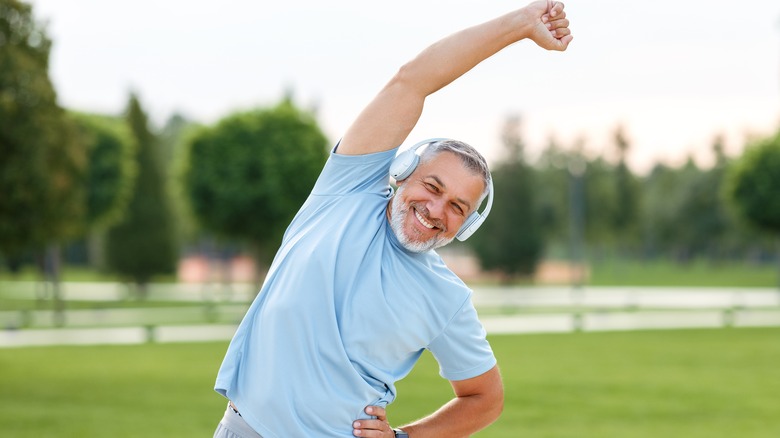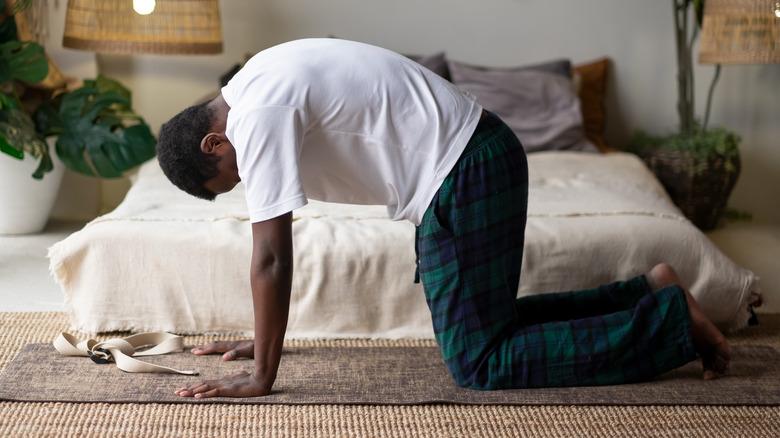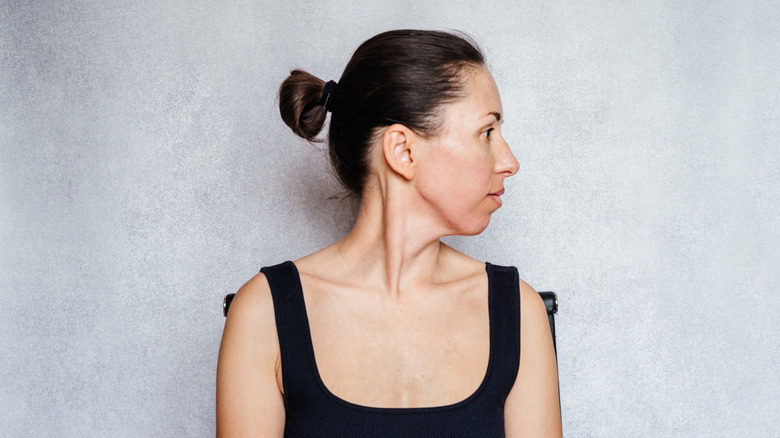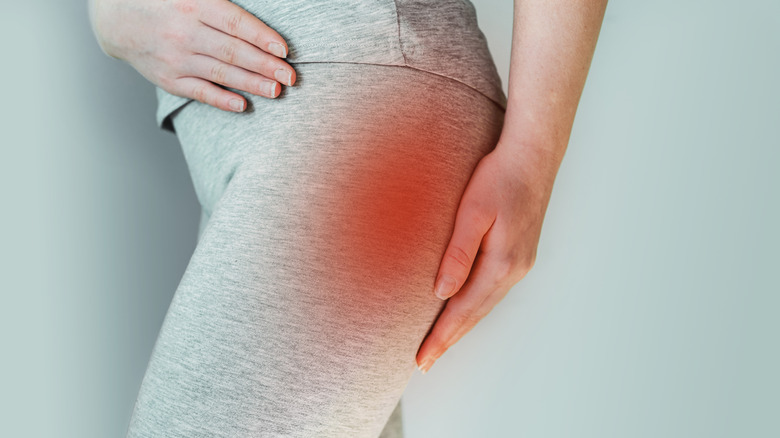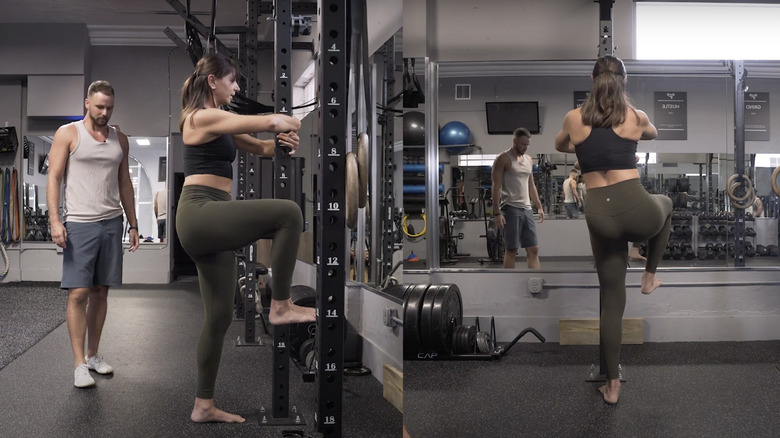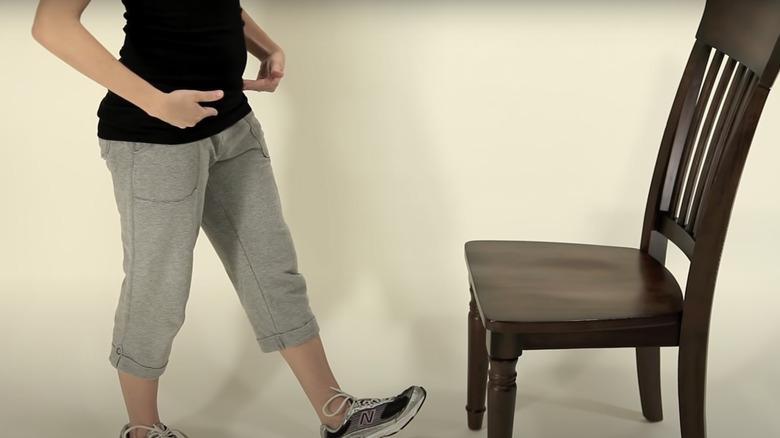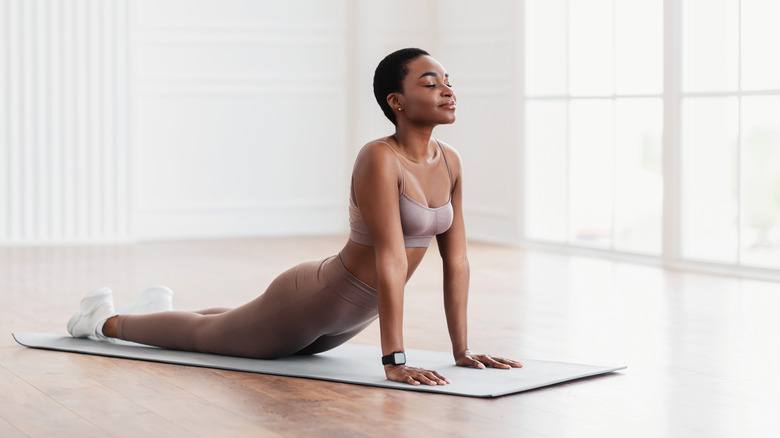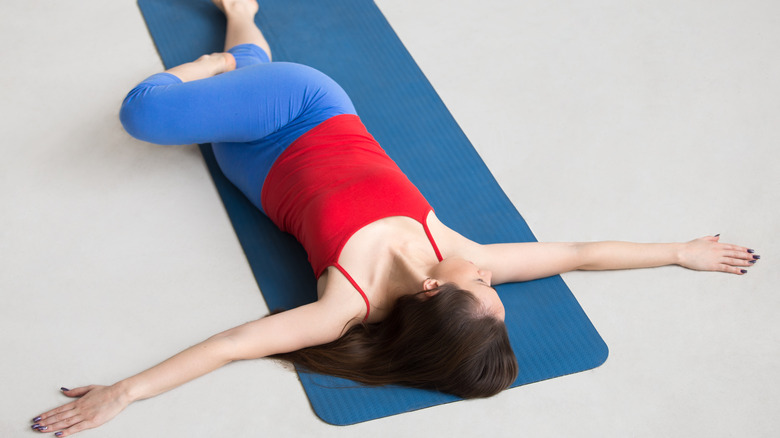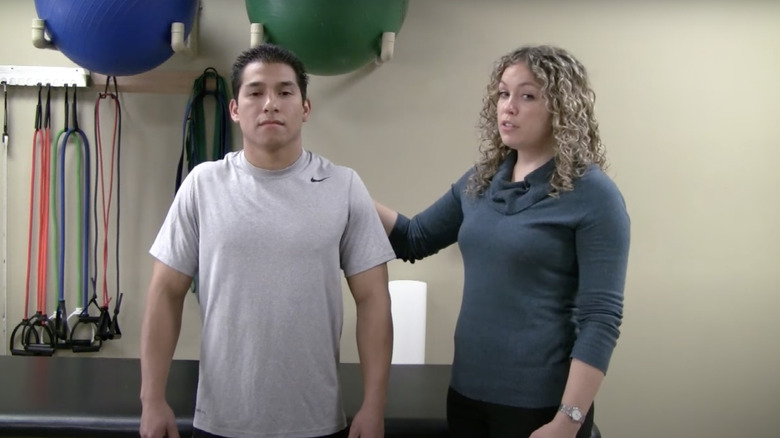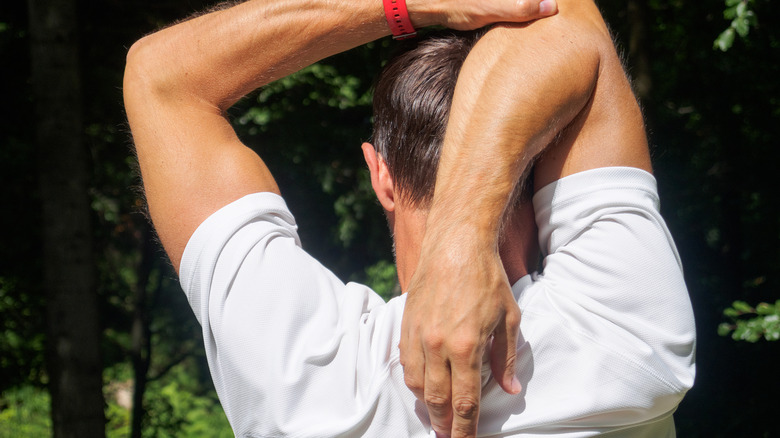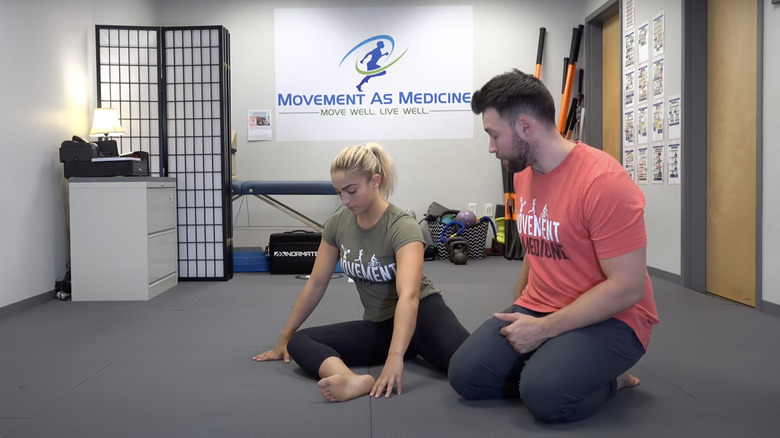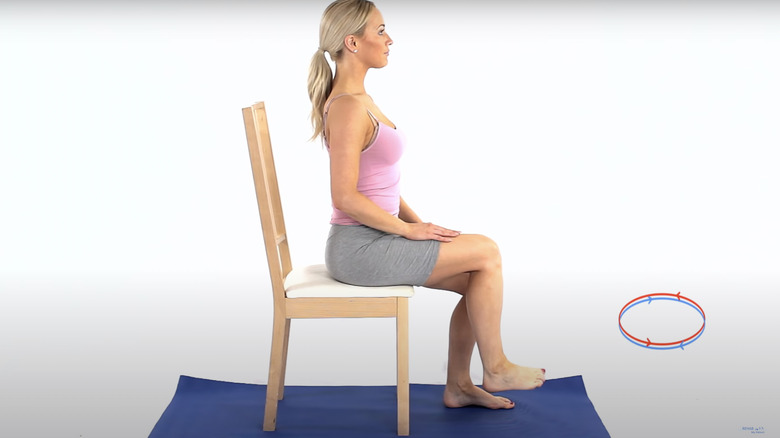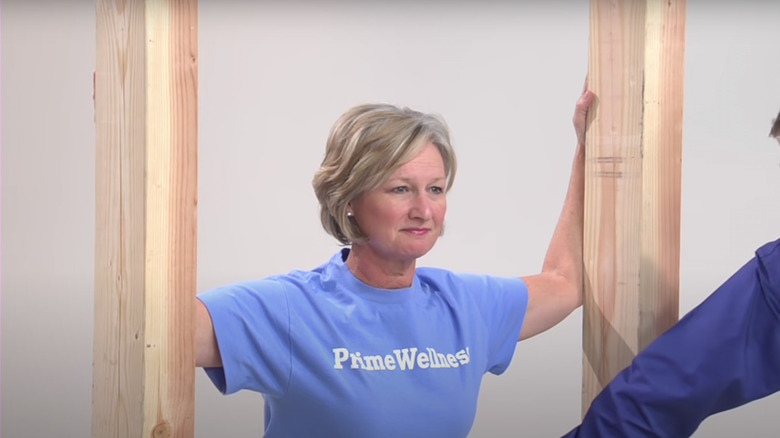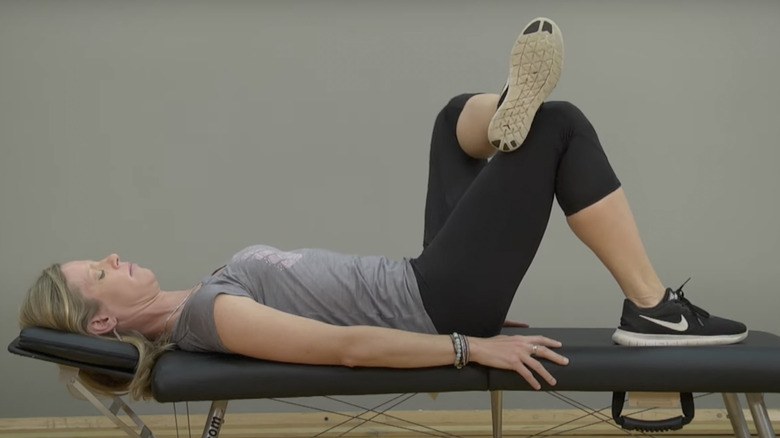Stretches You Should Be Adding To Your Daily Routine
Has your body been feeling a little stiff and creaky recently? If so, you might need a good old stretch. It can be easy to forget about the importance of stretching regularly, especially when we're not exercising. But giving yourself the time and space to engage and elongate your muscles is crucial. "A lot of people don't understand that stretching has to happen on a regular basis. It should be daily," states Massachusetts General Hospital-based physical therapist David Nolan to Harvard Health Publishing. The way we use our bodies when we're simply going about our day-to-day lives can tighten up our muscles, and stretching every day can allow us to regain flexibility and motion.
But let's be honest, folks, life is busy. You may not even have enough time in the day to grab a coffee in the morning or relax properly at night, so how can you be expected to carve out hours to test the right stretches for you? Well, luckily, you won't have to — we've done the hard work for you. Let's check out all the stretches you should be doing every day.
Cat-cow
There's a reason why the cat-cow is so beloved by exercise enthusiasts and fitness professionals alike: It's really good for you. The cat-cow stretch is an active movement designed to work into your spine, and it could be beneficial to relieve back pain as well as to promote better posture (per Healthline). Additionally, this stretch aligns your breath with the movement, which provides a meditative, relaxing aspect.
To do the cat-cow, start on your hands and knees, with your limbs stacked under your joints. Your spine should be neutral, with length through it. Breathe in, and as you do so, bring your chest up, allowing your spine to curve and your head to come up, so that your stomach is moving toward the ground (this is the "cow" portion of the movement). Make sure that your shoulders aren't bunching up around your ears. Then, breathe out, and bring your spine into a rounded position, with your tailbone and pelvis coming toward your body, for the "cat" part. Allow your head to come back down toward the floor, gently hanging down at the bottom of the movement. Alternate between "cow" and "cat" slowly, working into your spine, for around a minute, remembering to focus on your breath.
Neck rotations
We may not think about it very often, but our necks do a lot of work. Propping up our heads and allowing us to move them easily, our necks are involved in almost every movement in everyday life. But as time goes on, our postures can worsen, and as a result of this, we can start to hold our necks a little too far forward (per Spine-Health). This can make our necks tighten up, which can lead to aches and pains.
The solution to this, though, is but a simple stretch away. And they don't get much simpler than a neck rotation. Stand with your feet shoulder-width apart, or sit in a chair with your spine straight, and look straight ahead, trying to release any tension in your neck (per the Hospital for Special Surgery). Keep your head back, and then gently turn your head to one side, until you feel a gentle stretch through the side of your neck. After holding the stretch for a few seconds, turn your head so that it's back at center, and then to the other side, activating the stretch through the opposing side of the neck. Repeat the stretch several times on each side.
Piriformis stretch
When we stretch, we may tend to focus, first and foremost, on the larger muscles that provide power to our movements. But don't forget about the little guys. "Deep internal rotators, while small, produce a lot of the movement at the hip and are often overlooked," says certified strength and conditioning specialist Charlee Atkins to Self. These internal rotators, like the piriformis muscle that sits on the outside of your glute, allow your limbs to rotate effectively. When they get tight, they can irritate other parts of the body. Stretching out the piriformis could help you avoid this, and reduce your chances of developing sciatica, says Atkins.
Begin by sitting on the ground, with your legs outstretched. Then take one of your legs and cross it over the other, placing your foot flat on the ground on the outside of your still-extended leg. Place the elbow of your opposing arm on the outside of your bent leg's thigh, using your other hand to stabilize you behind your body. Then, use your elbow to gently press your outside hip into a stretch, twisting slightly at the spine (if the twist is too much for you, simply focus on the stretch in your hip).
Hip CARs
Of all the areas we should be stretching out every day, our hips should be near the top of the priority list. Our hips are prone to tightness, especially in those who spend a lot of time seated — and this tightness can lead to a cascade of problems elsewhere in the body, such as the lower back or knees (per Well+Good). But in news that might surprise you, static stretches are probably not the best way to stretch your hips. Instead, controlled articular rotations, or CARs, allow you to actively stretch your hip, using a circular motion that works into the whole joint, according to Livestrong. And this has some serious benefits. "Hip CARs can help improve mobility, joint health and range of motion by moving one single joint through its absolute full range while keeping the rest of your body still and contracted," says certified strength and conditioning specialist and physical therapist Grayson Wickham to Livestrong. What's not to like?
Begin in a standing position, facing a wall or exercise rack. Put both of your hands on the wall or rack to keep your body stable. Then, raise one of your knees in front of you, and without twisting your hips, start to move your leg out to the side, until it's the widest it can go without your body turning. From here, rotate your knee down in an inward motion, and then allow the knee to continue its rotation upward until your leg is behind you, then out to the side again, in a circular movement. Perform these rotations for around 60 seconds, and then repeat with the other leg.
Standing hamstring stretch
Your hamstrings are essential to your everyday movements, and yet, so many people struggle with tightness in these vital muscles. Often prompted by exercise, tight hamstrings can cause problems with your movement, and in certain situations, may even make it difficult to stand properly (per Medical News Today). The good news, though, is that loosening up your hamstrings usually takes no more than a robust daily stretch, and standing hamstring stretches are amongst the simplest you can do.
Stand with your feet a regular distance apart, and then place one of your feet forward slightly, with your toes up and flexing toward you, and the other leg bending a little, says Medical News Today. Then, start to bend over your extended leg, with your hands placed on your upper thigh to stabilize you. Pull your toes back as you do this, feeling the stretch along the back of your leg. Breathe into the stretch, and hold it for around 20 seconds or so before returning to a standing position and doing the same with the other leg. Stretch each leg about three times to generate even further flexibility.
Cobra pose
It can be tempting to stretch your muscles one by one, but if you want some bang for your daily stretching buck, full-body is the way to go. And they don't get much more full-body than the cobra pose. A cobra stretch activates and lengthens your abdominal muscles, while also working into your ankle and hip flexors, your pecs, your neck, and even your biceps, as Healthline states. Practicing it daily could improve your posture and ease lower back pain.
And the best thing is, it's super easy to do. Start by lying face-down on the floor, with your feet pointed so that the tops of them are resting against the ground. Place your palms flat on the floor next to your upper torso, ensuring that your upper arms are in alignment with your elbows. Then, breathe in, and use your hands to push your upper body up, curling your chest away from the floor, while your knees and lower legs stay connected with it. Keeping your elbows bent here will take you into a low cobra, which is better for folks who have back or neck issues — or keep pushing until your arms are straight, for a full cobra.
Spinal twist
Your spine sure does do a lot, huh, folks? It's pretty easy to forget that this collection of bones that runs down your back is a participant in almost everything we do (via University of Maryland Medical Center). But as we hunch and slouch our way through our days, our spine can become tense and painful (per Medical News Today), and one way to correct that is with a supine spinal twist. A staple in Yoga practices worldwide, supine spinal twists encourage flexibility in the back and keep your spine long and aligned, according to Yoga Basics.
Begin by lying flat on your back, with your arms stretched out to either side, palms flat on the floor. Bend one of your legs, keeping the other one extended and long, and place the foot of your bent leg on the knee of your straight one. Then, allow your bent leg to drop over your extended leg, with your hips moving with it into a twist position, while keeping the rest of your back and shoulders flat on the floor. Cast your gaze in the opposite direction, at your hand on the floor ideally. Breathe into the stretch, letting gravity do the work (although you can place your hand on your bent knee to stabilize it), for up 10 breaths. Then return to the start, and repeat on the other side.
Standing lunge stretch
The lunge is a fundamental move that is superb for stretching out your hip flexors and legs, and giving you better mobility and balance, as the American Council on Exercise (ACE) says. And what's more, lunges are also a strengthening exercise and can provide muscle-building benefits to your lower body, your back, and your core (per Healthline).
Stand up tall, your feet a regular width apart, with your core activated and your chest open, says ACE. Then lift one of your feet off the ground, and using the remaining leg to keep your body upright and stable, take a big step forward and land with your foot flat on the ground in front of you. Lean into the front leg so that your body comes down into a lunging position, ensuring that your abs remain engaged and your torso stays upright. Your front thigh should end up parallel to the floor, and your back leg should have a bend in the knee. Hold the position for around 30 seconds or so, feeling the stretch through your hip and thigh, and then push yourself back up to a standing position from your front leg.
Shoulder rolls
It's something we're all pretty familiar with. You're rushing through a stressful day, jumping from task to task and likely hunched over a keyboard, and then by the time you sign off for the evening, your shoulders are up by your ears. Our shoulders have a knack for holding our body's tension and stress, and shoulder rolls are a great way to diffuse this and return them to a relaxed state, says Spotebi. In doing so, shoulder rolls also introduce flexibility and improved circulation to the area, and can reduce shoulder and neck aches — and they're especially good to do before you do any exercise in your upper body.
Plant your feet at shoulder-width, standing up straight with your spine long and your shoulders relaxed and back. Move your shoulders forward, and then slowly rotate them in a backward motion, going up past your ears and pulling down your back. Continue the circle until they're in their original position, and repeat for around 30 seconds. After this, perform the motion in the other direction, for the same amount of time.
Overhead triceps stretch
No matter how much we extol the virtues of your triceps, the biceps are still the star of the show when it comes to people's visual desires for their arms. But we implore you to spend a little time on your tri's, too. Running along the back of your arm, your triceps are responsible for extending your arms and your shoulders, as well as keeping your shoulders supported when you're carrying bigger objects, says Healthline. So keeping them well-tended and well-stretched ensures that they remain flexible and ready to tackle the tasks of the day.
A simple overhead triceps stretch can do this. Stand up straight, or sit upright in a chair or on a bench, and ensure that your shoulders are relaxed and back, says ACE. Lift one of your arms toward the sky and then bend your elbow, and pull your hand back behind your head. Take your other hand and place it on your bent elbow, using it to encourage your bent arm and hand to move lower down your neck and back. You should feel the stretch through the back of your bent arm. Hold for around 30 seconds, and then repeat on the other side. ACE recommends 2-4 repetitions on each side, deepening the stretch on each round.
90/90 hip stretch
No matter what age you are, you need to look after your hips. Encouraging hip mobility — which, as personal trainer Stephanie Mellinger points out via CNBC, is different from flexibility, and allows us to better control our stretch and our muscles — keeps your pelvis and limbs moving easily and your back free of pains.
And to promote mobility in your hips, try the 90/90 stretch daily. Sit on the ground with one of your knees pointing straight to the side, leg bent at a 90-degree angle so your foot is pointing straight back. Your other bent leg should be in front of you, your knee facing straight forward and also bent at a 90-degree angle. This can be a pretty strong stretch, and for a lot of people, just staying in this position for a little while can encourage greater mobility. But if you think your body needs a little more encouragement, tilt your chest forward slightly, which will heighten the stretch in your front leg. Hold this position for up to 60 seconds, and then repeat the stretch on the other side to ensure that you're not creating an imbalance in your body. You can do this stretch as many as ten times per side.
Ankle circles
How often do you stretch your ankles? In fact, how often do you think about your ankles? We're pretty sure that most people only bring them into the forefront of their minds when they have an injury, but keeping them loosened and stretched can prevent this by opening up the joint and increasing blood flow, according to Spotebi.
And there's no need to change up your stretching routine with some wildly complicated ankle movement — a simple ankle circle will do the trick. Stand up straight, and then gradually lift one of your legs off the ground, with a slight bend in your knee. Then, simply draw circles with your toes, working into the ankle joint. Move in one direction for 30 seconds, and then repeat the movement in the other direction for the same amount of time. Plant your foot back on the ground and repeat with the other ankle. It's best to do these movements at the end of a stretching warmup to ensure that everything's limber before you begin your lower-body or full-body workout.
Doorway stretch
When you're stretching your body, how often do you include your biceps? Be honest, here, people. If you're like us, you probably don't consider bicep stretches a top priority, but there's good reason to include them in your everyday routine. Biceps are constantly contracting and being used throughout your day, whenever you pick things up and flex your elbow (per Men's Health). Stretching them allows them to reset and regain their natural length.
A doorway stretch can accomplish this with ease, while simultaneously giving your chest a stretch, too. Stand in an open doorway and place your forearms on either side of it, with your elbows at chest height, forearms extended upward along the doorjamb. Then lean forward until you feel the stretch through your arms (as well as your chest). Remaining careful here is key: Don't jerk or pull your body forward too much, and stop leaning if you feel any discomfort, particularly around your shoulders. Hold this stretch for anywhere between 30-60 seconds to make the most of it, and then return to your starting position.
Lying figure-four stretch
The glutes tend to get a lot of action throughout the day, as muscles that help us generate power when walking, running, or lifting. But when you use them, or even if you're just sitting for extended periods, they can start to tighten up. When this happens, you're going to want to watch out, as "tight glutes can cause muscular imbalances in the kinetic chain, which can lead to injury," says running coach and Marathon Handbook founder Thomas Watson via Runner's World. Runner's knee and back pain can each be a consequence of tight glutes, so stretching them out is super important.
To do this, the lying figure-four stretch is worth mastering. Lie on the floor in a supine position, and then lift your knees, placing your feet flat on the ground or mat. Take one of your feet and cross it over the other leg, with the ankle against the knee. Take your hands, clasp them together under the knee of the leg still connected to the floor, and then pull your leg toward your upper body, without lifting your back off the ground. Hold the stretch for up to 30 seconds, and then return your foot to the ground before repeating with the other leg.

